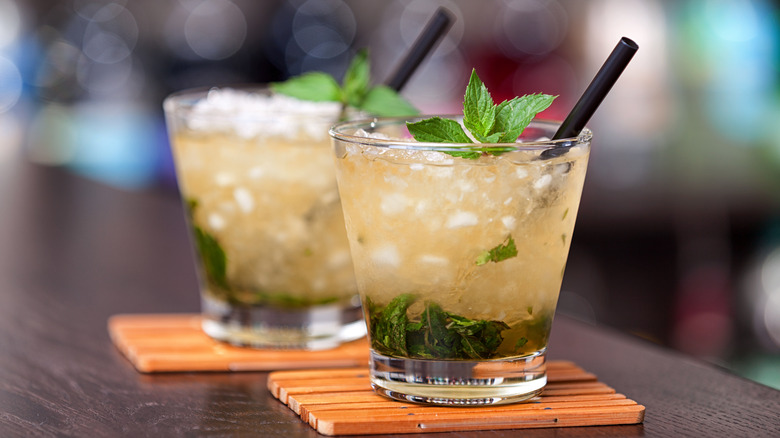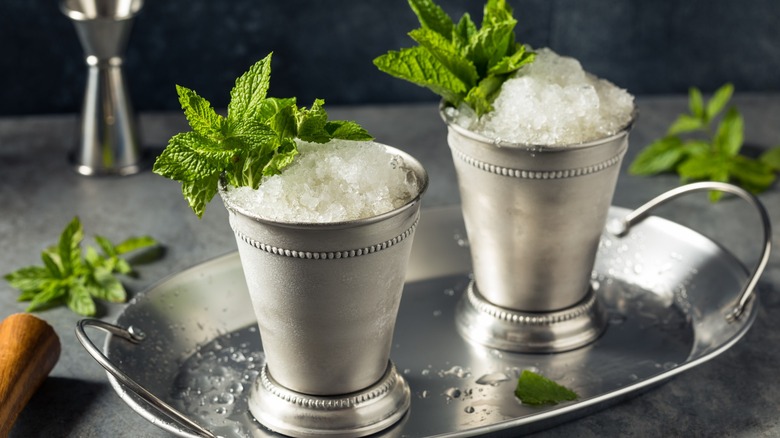Bourbon Isn't Actually The Original Spirit Used In Mint Juleps
The mint julep is a classic cocktail that you can find in almost any bar, right alongside the "medium-dry vodka martini, shaken, not stirred" that James Bond first ordered in 1962's "Dr. No." (via TheProGamerJay). If you're familiar with this drink, you'll know that bourbon plays a vital role in its recipe, alongside sugar and fresh mint leaves. But you might be surprised to learn that it hasn't always been this way.
Originally, the mint julep wasn't even a cocktail at all. It was conceived at the start as a sort of elixir for stomachaches and throat issues. This is where the name "julep" came from, as it was a catch-all term to describe medicinal syrups. The way people made a proto-mint julep back then wasn't very different from how we make it today at the bar: Mixing a strong spirit with an equal part of water, sweetening it with a few sugar cubes, and then infusing it with fresh mint leaves. Did it really work as a medicine? No one knows for sure, but one thing is clear — it was delicious!
You might have noticed that we mentioned "strong spirit" without specifying bourbon. That's because, at the time, the type of spirit didn't matter as long as it had a kick. From cheap high-proof rum to rye whiskey and moonshine, early mixologists used whatever was on hand. It wasn't until the United States gained its independence in the 1700s, and whiskey — particularly bourbon — became a symbol of the southern U.S., that it gradually evolved to become the preferred spirit in the mint julep, a title it still holds today.
Bourbon's long, hard road to reach the mint julep
While the idea of using bourbon in a mint julep gained popularity in the 1700s, it was during the Civil War era of the 1800s that bourbon's role in this classic cocktail became firmly established. The war caused grape shortages, which, in turn, led to a decline in the availability of the once-popular brandy. Bourbon, with its robust flavor and widespread availability, stepped in to fill the void. This marked the beginning of bourbon's long-standing connection with the mint julep, which continued even after the war ended in Virginia in 1865 – incidentally, also considered the birthplace of the mint julep.
However, bourbon (and the mint julep itself) faced challenges during the Prohibition Era when distilleries were forced to close. This allowed foreign spirits like scotch and rum to dominate the speakeasy scene. After Prohibition was repealed, the bourbon industry launched marketing campaigns to reintroduce it as a respected spirit. This resurgence also meant a comeback for the mint julep. Yet, the strong promotion of bourbon during that time overshadowed the drink's diverse historical origins.
That's why, today, you'll be hard-pressed to find anyone making mint juleps with anything but bourbon. For most people, that's how it's always been served. But there's good news: Many bartenders are expressing an interest in historical authenticity and are setting out to explore the mint julep's (and other cocktails') rich past. You'll now find many recipes that incorporate cognac, like the Sonneville mint julep, or, yes, rum! Using different spirits removes the bourbon's smoky, overpowering notes and instead enhances the drink's sweeter and fruitier flavors.

